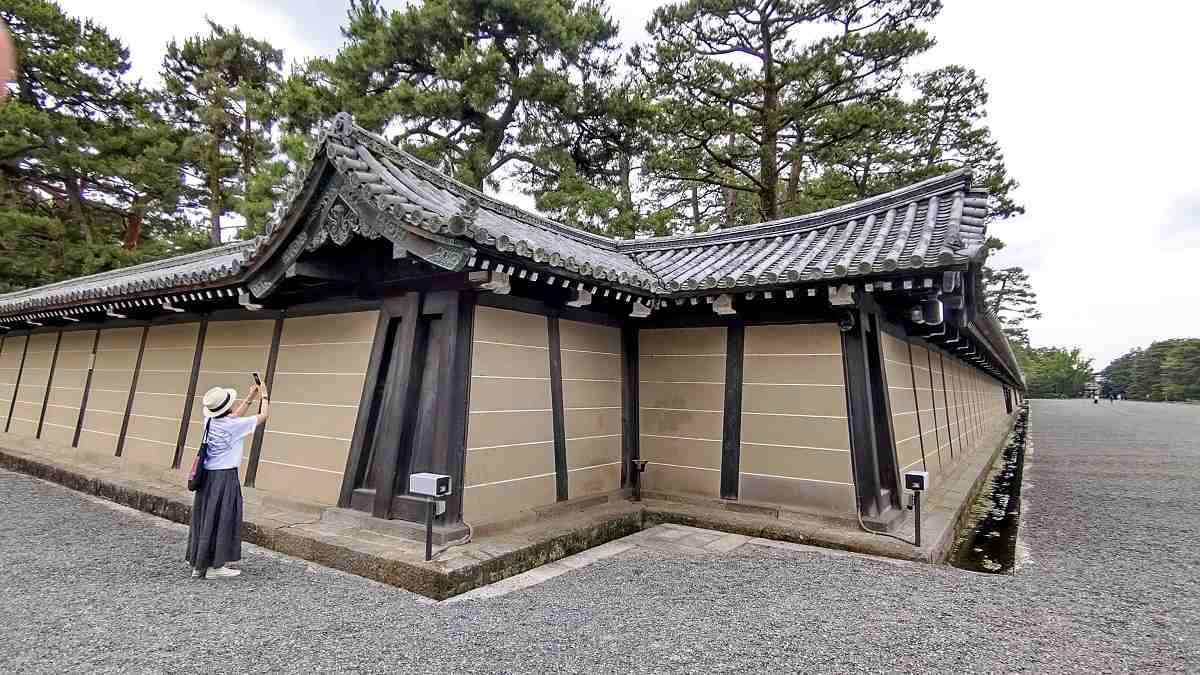Secrets of Kyoto / Bent Walls And Monkey Statues: Kyoto’s Kimon Yoke Ward Off Demons; Traditional Installations Still Guard “Unlucky” Corners

White pebbles are spread to cover a small square area at the northeast corner of a fan shop in Nakagyo Ward, Kyoto.
13:12 JST, July 15, 2024
Recessed walls, monkeys guard ‘demon’ gates
The former residence of emperors, the Kyoto Imperial Palace, in Kyoto’s Kamigyo Ward, stands on a rectangular plot of land measuring about 450 meters from north to south and about 250 meters from east to west. There is an interesting spot at one of the corners of the tsuijibei, a roofed wall, that surrounds the premises. At the northeastern corner, the wall recesses in an L shape. This is what is known as a “kimon yoke,” a traditional building feature meant to protect the area from demons.
In Japan, it was long believed that demons, or oni, representing disasters such as infectious diseases, fire and natural disasters, would come and go through the kimon, which means “demon gate.”
Ancient pseudoscience, which attempted to predict good and bad fortune based on factors, including the calendar and the movements of celestial bodies, held that two complementary forces, yin and yang, make up all aspects and phenomena in life. In this philosophy, the northeast is considered to be an unlucky direction.
Thus, the kimon is thought to be in the northeast corner, and so the corner of the palace is recessed to eliminate the demon gate.

A statue of a monkey meant to ward off demons is set on the roof of the haiden (hall of worship) of Sekizanzenin temple in Sakyo Word, Kyoto.
There is also a carved wooden monkey statue placed under the roof of the wall. The animal is considered an agent of the deity enshrined at Hiyoshi Taisha shrine, in the city of Otsu, and is believed to prevent the entrance of demons.
The deity enshrined at Hiyoshi Taisha is the guardian deity of Hieizan Enryakuji temple, also in Otsu. Thanks to its location to the northeast of Kyoto, the deity is believed to protect all of Kyoto from demons.
One may find it strange that a Shinto deity protects a Buddhist temple, but a syncretic blend of Shinto and Buddhism was practiced in Japan from ancient times. In this religious framework, Shinto, Japan’s native belief system, was united with Buddhism, which came from India through China and the Korean Peninsula.
Although Shinto was separated from Buddhism in 1868 under an ordinance issued by the Meiji government, remnants of the ancient belief framework can still be found in many places.
Sekizanzenin, in northeastern Kyoto’s Sakyo Ward, is a branch temple of Hieizan Enryakuji; its location puts it closer to the city center than Enryakuji proper. A statue of a monkey intended as a kimon yoke is also found on the roof of Sekizanzenin’s haiden (hall of worship).
Sekizanzenin’s principal deity has a Shinto name — Sekizan Daimyojin — but it was originally known as Taizan Fukun, a Taoist deity brought from China.
There are many similarities between Shintoism and Taoism, so many Japanese people feel no qualms about worshiping those gods as well.
It must be added that another kimon is thought to exist at the southwest corner, called the ura (back) kimon. This is also connected to the philosophy of yin and yang
What protects Kyoto from ura kimon is Iwashimizu Hachimangu shrine in the prefecture’s southwestern city of Yawata. The shrine’s main founders were Buddhist monks, which is why it still displays traces of Shinto-Buddhist syncretism.

The northeastern corner of the stone wall around the main hall building of Iwashimizu Hachimangu shrine in Yawata, Kyoto Prefecture, is cut off as a kimon yoke.
While Iwashimizu Hachimangu itself serves as protection against demons, the northeastern corner of the stone wall around the shrine’s main hall building is also cut off as a kimon yoke.
Although not so common, kimon yoke can also be found in private buildings. These kimon yoke are created by either eliminating the northeast corner; filling a small square space at the northeast corner with white stones or gravel; or planting a plant — nanten (nandina, or heavenly bamboo) and holly are most common — at the northeast corner.
Such measures to ward off demons are more common in Kyoto than in other cities. This may be due to the influence of the Kyoto Imperial Palace and the city’s shrines and temples, but there is another possible reason.
In Kyoto, which features an orderly, grid-like layout of streets running in parallel from north to south and from east to west, it is very clear where the northeast and southwest corners are on any given street-facing plot of land. People in the city are believed to be unable to forget about the directions, even though they know that caring about them is a kind of superstition.

The northeast corner of the Kyoto Imperial Palace in Kamigyo Ward, Kyoto, is recessed as a kimon yoke. Out of view a wooden monkey statue is seen guarding the corner where a woman is pointing her smartphone.
"JN Specialities" POPULAR ARTICLE
-

The Japan News / Weekly Edition (12/12-12/18)
-

English-language Kabuki, Kyogen Entertain Audiences in Tokyo; Portland State University Professor Emeritus, Graduates Perform
-

Noodle Dining Shunsai / Rich Oyster Ramen to Savor at Odasaga; Experienced 68-year-old Owner Creates Numerous Ramen Varieties
-

The Japan News / Weekly Edition (12/5-12/11)
-

People Keep Loved Ones’ Ashes Close in Special Jewelry, Small Urns as Unique Way to Memorialize Them
JN ACCESS RANKING
-

Keidanren Chairman Yoshinobu Tsutsui Visits Kashiwazaki-Kariwa Nuclear Power Plant; Inspects New Emergency Safety System
-

Imports of Rare Earths from China Facing Delays, May Be Caused by Deterioration of Japan-China Relations
-

University of Tokyo Professor Discusses Japanese Economic Security in Interview Ahead of Forum
-

Japan Pulls out of Vietnam Nuclear Project, Complicating Hanoi’s Power Plans
-

Govt Aims to Expand NISA Program Lineup, Abolish Age Restriction
























